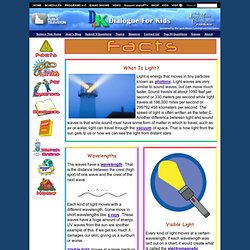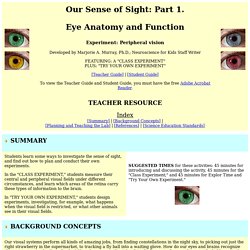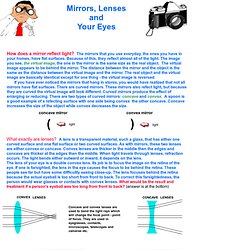

KS3 Light. Ontario Science Centre: Mixing Colours. Light and Color. What Is Light?

Light is energy that moves in tiny particles known as photons. Light waves are very similar to sound waves, but can move much faster. Sound travels at about 1090 feet per second or 330 meters per second while light travels at 186,000 miles per second or 299792.458 kilometers per second. The speed of light is often written as the letter C. Another difference between light and sound waves is that while sound must have some form of matter in which to travel, such as air or water, light can travel through the vacuum of space.
Wavelengths The waves have a wavelength. Each kind of light moves with a different wavelength. Visible light moves at a more medium wavelength – that is why we can see it. Then there are the longer wavelengths. Longer and shorter wavelengths are not visible to our eyes without special equipment. Neuroscience for Kids - The Eye and Its Connections. Our visual systems perform all kinds of amazing jobs, from finding constellations in the night sky, to picking out just the right strawberry in the supermarket, to tracking a fly ball into a waiting glove.

How do our eyes and brains recognize shape, movement, depth, and color? How do we so easily pick a friend's face out of a crowd, yet get fooled by optical illusions? In this first of three units on the Sense of Sight, we consider the anatomy and physiology of the eye, especially the retina, and the initial pathways visual information takes to the brain. Part 2 discusses how various aspects of a visual scene are processed at higher levels, and Part 3 delves into color vision. 1. Most animals and many plants are photosensitive; that is, they can detect different light intensities. Higher invertebrates and virtually all vertebrates have complex, image-forming eyes, and we will "focus" on the refracting eye found in the octopus and in all vertebrates. Figure 1. 2. Figure 2. KS2 Bitesize Science - Shadows : Read.
How Your Eyes Work. Youtube. Science S2 - Light Fantastic - Glenorie Public School. Lens, Light and Your Eyes. Mirrors, Lenses and Your Eyes Concave and convex lenses are used to bend the light rays which will change the focal point - point of focus.

They are used in eyeglasses, contacts, microscopes, telescopes and cameras etc. FARSIGHTED focuses behind the eye NEAR SIGHTED focuses in front of the eye Corrective Lense To reflection and refraction p.3 How does a mirror reflect light? If you have ever noticed the mirrors that hang in stores, you would have realized that not all mirrors have flat surfaces. What exactly are lenses? The lens of your eye is a double convex lens. NEAR SIGHTED Corrective Lense Your eye and a camera are quite similar. If one is nearsighted, the lens in the eye causes the focus to be behind the retina. Copyright 2005, bj All Rights Reserved. Untitled Document. Light does appear to travel in straight lines In a dusty atmosphere it is sometimes possible to see light travelling and it does appear to be moving in a straight line.

The fact that light travels can be demonstrated by putting an object in its path. If the object is opaque the result is a degree of blackness on the other side of it which is due to the absence of the light. The dark area is a shadow. As light does appear to travel in straight lines then light is usually modelled as straight lines in drawings. Shadows can provide evidence that light travels in straight line. When light come into contact with the surface of an object it can do one of four things.
The difference between reflection and scattering is dependant upon the nature of the surface of the object. Reflection of light from a smooth surface can be compared to a billiard ball being bounced off the side of the billiard table. Contents. Science Notebook - Light 1. A beam of light travels at about 186,000 miles per second.

That is equal to over seven times the distance around the earth in just one second! But what exactly is light? We know it when we see it, and we also know that we could not see without it, but that doesn’t tell us what it is. Light for Kids. Kids Science - Light Reflection, Kids Bouncing Light Experiments. Mr Collinson's Grade 4 Science - Light and Sound. Reflection. Shadows & Light Theme - Lesson Plans, Thematic Units, Printables, Worksheets. Light and Shadows Interactive Science Revision - Games and Activities. Light.